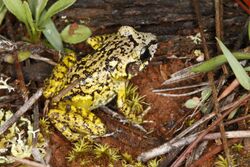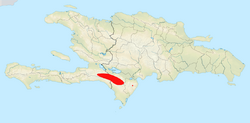Biology:Southern pastel frog
| Southern pastel frog | |
|---|---|

| |
| Scientific classification | |
| Domain: | Eukaryota |
| Kingdom: | Animalia |
| Phylum: | Chordata |
| Class: | Amphibia |
| Order: | Anura |
| Family: | Eleutherodactylidae |
| Genus: | Eleutherodactylus |
| Species: | E. leoncei
|
| Binomial name | |
| Eleutherodactylus leoncei Shreve and Williams, 1963
| |
The southern pastel frog[1] or Hispaniola robber frog (Eleutherodactylus leoncei) is a species of frog in the family Eleutherodactylidae. It is endemic to Hispaniola and known from the Massif de la Selle, both in the Dominican Republic and in Haiti.[2] Its natural habitats are upland pine forests. Males call from the ground. It is threatened by habitat loss caused by logging and agriculture. It is known from the Sierra de Bahoruco National Park (Dominican Republic), but habitat degradation is occurring in this area too.[1]
Taxonomic history
E. leoncei was described by Shreve & Williams in 1963. The type-locality for the species is Foret des Pins, near Pic La Selle in Haiti. The holotype (YPM 1167) is an adult female collected the 26 February 1959 by P. S. Humphrey.
Distribution and habitat
The type series and the majority of subsequent specimens were collected during the day under rocks and logs in pine (Pinus occidentalis) and hardwood forests, while one was discovered crossing a road in a pine forest at night.[3]
This species is restricted to the Massif de la Selle in Haiti, and Sierra de Bahoruco in the Dominican Republic, Hispaniola. It has been recorded from 1,182 to 2,303 m asl.[4][5]
It is considered a terrestrial species that lives in upland pine forests, preferring shady spots and calling from the ground. It will not tolerate disturbances to its natural environment. It breeds by direct development and lays its eggs on the ground.[6]
Conservation
The species is found in Parque Nacional Sierra de Bahoruco in the Dominican Republic, but the region is poorly protected, and habitat loss is ongoing. It is important to improve the management of existing protected areas and maintain the remaining habitat.[7]
The main threat is habitat loss caused by logging (charcoaling) and slash-and-burn agriculture carried on by local communities.[7] This region has been recently affected by multiple forest fires, some of which have been caused by illegal human activities within the park boundaries.[8]
Because of a projected population loss of more than 80% in the next ten years due to extreme destruction of the species' habitat in Hispaniola, the species is listed as Endangered by the IUCN.[7]
Images
References
- ↑ 1.0 1.1 1.2 IUCN SSC Amphibian Specialist Group (2022). "Eleutherodactylus leoncei". IUCN Red List of Threatened Species 2022: e.T56712A3047929. https://www.iucnredlist.org/species/56712/3047929. Retrieved 1 August 2022.
- ↑ Frost, Darrel R. (2015). "Eleutherodactylus leoncei Shreve and Williams, 1963". Amphibian Species of the World: an Online Reference. Version 6.0. American Museum of Natural History. http://research.amnh.org/vz/herpetology/amphibia/Amphibia/Anura/Eleutherodactylidae/Eleutherodactylinae/Eleutherodactylus/Eleutherodactylus-leoncei.
- ↑ Hedges, S. B. (1992). "A reconsideration of two montane species of Eleutherodactylus in Hispaniola (Anura, Leptodactylidae)". Caribbean Journal of Science 28: 11-16. http://www.hedgeslab.org/pubs/43.pdf.
- ↑ "Eleutherodactylus leoncei Shreve and Williams, 1963 | Amphibian Species of the World". https://amphibiansoftheworld.amnh.org/Amphibia/Anura/Brachycephaloidea/Eleutherodactylidae/Eleutherodactylinae/Eleutherodactylus/Eleutherodactylus-leoncei.
- ↑ "Map of Life - Species Maps". https://mol.org/species/Eleutherodactylus_leoncei.
- ↑ Schwartz, Albert (1991). Amphibians and reptiles of the West Indies : descriptions, distributions, and natural history. Robert W. Henderson. Gainesville: University of Florida Press. ISBN 0-585-19242-1. OCLC 44958544. https://www.worldcat.org/oclc/44958544.
- ↑ 7.0 7.1 7.2 Hedges, Blair; Inchaustegui, Sixto; Powell, Robert (2008-12-18). "IUCN Red List of Threatened Species: Eleutherodactylus leoncei". https://www.iucnredlist.org/fr.
- ↑ Gómez, Julio (2021-03-02). "Tres incendios han afectado la Sierra de Bahoruco en una semana" (in es). https://elnacional.com.do/tres-incendios-han-afectado-la-sierra-de-bahoruco-en-una-semana/.
Wikidata ☰ Q2276454 entry
 |






